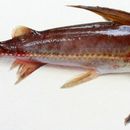en
names in breadcrumbs


Doras carinatus is a species of thorny catfish found in Brazil, French Guiana, Guyana, Suriname and Venezuela. This species grows to a length of 30.0 centimetres (11.8 in) SL. This species can emit sounds by moving its pectoral spines. Every basic unit of sound emitted lasts for 60–70 milliseconds, with a frequency of 60–90 hertz corresponding to the reply frequency of the muscles utilized.[1]
Doras carinatus is a species of thorny catfish found in Brazil, French Guiana, Guyana, Suriname and Venezuela. This species grows to a length of 30.0 centimetres (11.8 in) SL. This species can emit sounds by moving its pectoral spines. Every basic unit of sound emitted lasts for 60–70 milliseconds, with a frequency of 60–90 hertz corresponding to the reply frequency of the muscles utilized.